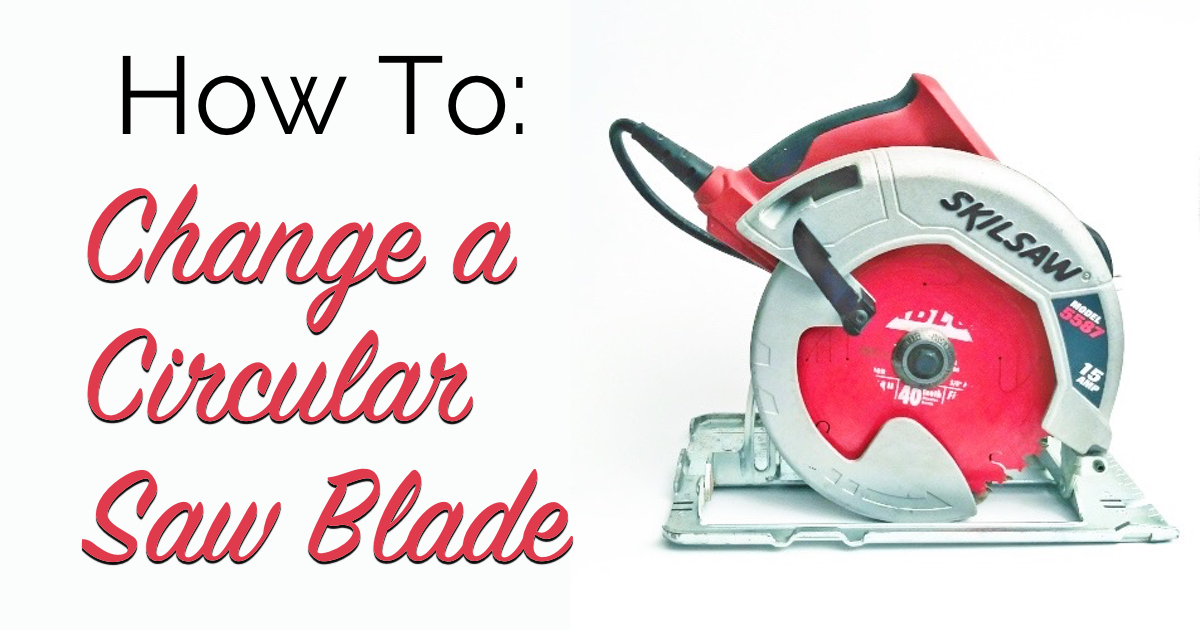How do you change a Craftsman circular saw blade? Changing a Craftsman circular saw blade involves unplugging the saw, loosening the arbor nut (usually with a wrench that comes with the saw), removing the old blade, installing the new blade in the correct direction, and then tightening the arbor nut securely. Safety is the most important aspect, so always wear safety glasses and gloves. Let’s explore this process in detail, prioritizing safe practices throughout.

Image Source: thecraftsmanblog.com
Importance of Safety When Changing a Saw Blade
Craftsman circular saws are powerful tools that can be extremely useful in a variety of projects. However, they can also be dangerous if not handled correctly. The sharp blade rotating at high speeds presents a significant risk of injury. That’s why changing saw blade safely is paramount.
Before you even think about Craftsman circular saw blade replacement, internalize this mantra: Safety First. This isn’t just a suggestion; it’s an absolute requirement. A moment of carelessness can lead to serious injury.
Preparing for Your Craftsman Circular Saw Blade Replacement
Before you begin the process of replacing circular saw blade Craftsman, ensure you have the necessary equipment and a safe workspace.
Essential Tools and Materials
- New Circular Saw Blade: Ensure it’s the correct size and type for your Craftsman saw and intended use.
- Circular Saw Blade Wrench: Most Craftsman saws come with a specialized wrench for loosening and tightening the arbor nut. Verify the circular saw blade wrench size before starting.
- Gloves: To protect your hands from cuts and abrasions.
- Safety Glasses: To shield your eyes from debris.
- A Clean Work Surface: A stable and well-lit area to work.
- A Block of Wood: To prevent the blade from spinning while loosening the nut.
Creating a Safe Workspace
- Disconnect the Power: This is non-negotiable. Unplug the saw from the power outlet before you do anything else. Removing the battery for cordless models is equally critical.
- Good Lighting: Ensure ample light to clearly see what you’re doing.
- Clear Surroundings: Remove any obstacles or clutter that might get in your way.
- Stable Platform: Place the saw on a stable surface to prevent it from moving or falling.
Step-by-Step Guide to Craftsman Circular Saw Blade Removal
Now that you’re prepared, let’s get started with the circular saw blade removal. Follow these steps carefully:
Step 1: Locating the Arbor Lock Button
Most Craftsman circular saws have an arbor lock button. This button, when engaged, prevents the blade from spinning, making it easier to loosen the arbor nut. The location varies by model, but it’s usually near the blade.
- Older Models: The lock might be on the side of the motor housing.
- Newer Models: Often located near the blade guard lever.
Step 2: Engaging the Arbor Lock
- Press and Hold: Press and hold the arbor lock button.
- Rotate the Blade: Manually rotate the blade until the arbor lock engages fully. You’ll feel or hear a click when it locks.
Step 3: Loosening the Arbor Nut
This is the trickiest part. The arbor nut is often very tight and the direction it loosens can be confusing.
- Determine the Direction: Craftsman saws typically have a right-hand thread. This means you loosen the nut by turning it clockwise (as viewed from the side with the nut). Consult your saw’s manual to confirm. Some models may require an Allen wrench.
- Use the Wrench: Fit the circular saw blade wrench onto the arbor nut.
- Apply Force: Using firm, steady pressure, turn the wrench in the correct direction to loosen the nut. You may need to apply significant force.
- A Gentle Tap: If the nut is stubborn, a gentle tap on the wrench with a rubber mallet might help.
Step 4: Removing the Arbor Nut, Washer, and Old Blade
Once the nut is loosened:
- Fully Unscrew: Unscrew the nut completely by hand.
- Remove Washer: Remove the outer washer. Take note of its orientation.
- Carefully Remove Blade: Gently slide the old blade off the arbor. Be careful of the teeth; they are sharp!
- Retain Parts: Keep the nut and washer in a safe place. You’ll need them for the new blade.
Installing New Circular Saw Blade
With the old blade removed, you’re ready for installing new circular saw blade.
Step 1: Cleaning the Arbor and Washers
Before installing the new blade, clean the arbor and washers.
- Inspect: Check for any dirt, debris, or rust.
- Clean: Wipe with a clean cloth. A wire brush can be used for stubborn rust.
Step 2: Mounting the New Blade
- Correct Direction: This is vital. The blade must be mounted with the teeth pointing in the direction of rotation. Most blades have an arrow indicating the correct direction. The teeth should point towards the front of the saw at the bottom.
- Align the Arbor Hole: Slide the new blade onto the arbor, ensuring the arbor hole is properly aligned.
- Install Washers: Replace the washers in the correct order and orientation.
Step 3: Securing the Arbor Nut
- Thread the Nut: Thread the arbor nut back onto the arbor by hand.
- Tighten with Wrench: Use the wrench to tighten the nut securely. Tighten it firmly, but avoid over-tightening, which can damage the threads or warp the blade.
Step 4: Testing the Blade
- Release Arbor Lock: Release the arbor lock button.
- Spin the Blade: Manually spin the blade to ensure it rotates freely and doesn’t wobble.
- Re-engage Arbor Lock: Engage the arbor lock again. Give the nut one final snug tightening.
Post-Blade Change Inspection
After completing the Craftsman saw blade change instructions, perform a thorough inspection to ensure everything is secure and functioning correctly.
Visual Inspection
- Blade Alignment: Check that the blade is properly aligned with the saw’s base plate.
- Nut Security: Verify that the arbor nut is tight.
- Blade Guard Operation: Ensure the blade guard moves freely and returns to its protective position automatically.
Functional Testing
- Plug in the Saw: Carefully plug the saw back into the power outlet (or re-insert the battery).
- Brief Test Run: Perform a brief test run in a safe environment. Listen for any unusual noises or vibrations.
- Check Cut Quality: Make a test cut on a piece of scrap wood. Examine the cut for smoothness and accuracy.
Craftsman Circular Saw Maintenance: Keeping Your Saw in Top Condition
Proper Craftsman circular saw maintenance extends the life of your saw and ensures safe operation.
Regular Cleaning
- Dust and Debris Removal: Regularly remove dust, sawdust, and debris from the saw’s motor, blade guard, and base plate.
- Compressed Air: Use compressed air to blow out hard-to-reach areas.
Blade Maintenance
- Sharpening: Dull blades are not only inefficient but also more dangerous. Sharpen your blades regularly or replace them when they become too dull.
- Storage: Store blades in a dry, protected environment to prevent rust and damage.
Inspecting Power Cord and Components
- Cord Condition: Regularly inspect the power cord for any signs of damage, such as cuts, fraying, or exposed wires. Replace damaged cords immediately.
- Moving Parts: Check the blade guard, base plate, and other moving parts for smooth operation. Lubricate as needed.
Troubleshooting Common Blade Change Problems
Sometimes, things don’t go as planned. Here are some common problems and how to address them.
- Stuck Arbor Nut:
- Problem: The arbor nut is too tight to loosen.
- Solution: Apply penetrating oil to the nut and let it sit for a few minutes. Use a longer wrench or a breaker bar for added leverage. A gentle tap with a rubber mallet can also help.
- Blade Won’t Fit:
- Problem: The new blade doesn’t fit onto the arbor.
- Solution: Ensure you have the correct blade size and arbor hole diameter for your saw. Check for any obstructions or debris on the arbor.
- Blade Wobbles:
- Problem: The blade wobbles after installation.
- Solution: Re-check the blade mounting. Ensure the blade is seated properly on the arbor, the washers are in the correct order, and the arbor nut is securely tightened. A bent blade can also cause wobbling.
Table: Common Issues and Solutions for Blade Changing
| Issue | Possible Cause | Solution |
|---|---|---|
| Stuck Arbor Nut | Over-tightened, Rust | Apply penetrating oil, Use longer wrench, Tap with rubber mallet |
| Blade Won’t Fit | Wrong Size, Obstructed Arbor | Verify blade size, Clean arbor, Ensure correct arbor hole diameter |
| Blade Wobbles | Improper Mounting, Bent Blade | Re-check mounting, Ensure washers are correct, Check for bent blade |
| Arbor Lock Not Engaging | Debris, Malfunction | Clean around lock mechanism, Check for damage, Consult service manual |
| Stripped Nut Thread | Over-tightening | Replace arbor nut and potentially the arbor itself |
FAQ: Frequently Asked Questions
-
What size wrench do I need for my Craftsman circular saw?
The specific wrench size varies depending on the Craftsman circular saw model. The circular saw blade wrench size is usually a standard size, often 13mm, 16mm, or 19mm. Check your saw’s manual or the wrench that came with the saw for the correct size.
* Can I use any brand of blade on my Craftsman circular saw?Yes, you can use any brand of blade as long as it’s the correct diameter and has the appropriate arbor hole size for your Craftsman saw. Ensure the blade is designed for the type of material you’ll be cutting (wood, metal, etc.).
* How often should I change my circular saw blade?The frequency of blade changes depends on usage and the type of material being cut. Change the blade when it becomes dull, damaged, or if you notice a decrease in cutting performance.
* What if I lost the wrench that came with my saw?You can purchase a replacement wrench at most hardware stores. Be sure to get the correct size for your saw’s arbor nut. You can also use an adjustable wrench, but it’s best to use the correct size wrench for a more secure fit.
* Is it safe to use a damaged circular saw blade?No, it is not safe to use a damaged circular saw blade. A damaged blade can break apart during use, causing serious injury.
* How do I dispose of an old circular saw blade?Wrap the old blade securely in cardboard or heavy paper, and tape it well to prevent accidental cuts. Label it clearly as “Sharp Object” before disposing of it in the trash. Some recycling centers may also accept metal blades.
* What is the correct direction to install a circular saw blade?The teeth of the blade should point in the direction of rotation, which is typically forward at the bottom of the saw. Most blades have an arrow indicating the correct direction.
* What should I do if the arbor lock doesn’t engage?Check for any debris or obstructions around the arbor lock mechanism. If the lock still doesn’t engage, there may be an internal problem, and you should consult a qualified repair technician.
Conclusion: Safe and Effective Blade Changes
Changing a circular saw blade might seem daunting, but with the correct tools, a clear process, and an unwavering commitment to safety, you can confidently perform this essential task. Remembering the steps outlined for Craftsman saw blade change instructions, including safety measures and routine saw maintenance, will ensure not only a safe blade replacement but also extend the life and performance of your Craftsman circular saw. Prioritize safety, and happy woodworking!

Hi, I’m Tom Scalisi, and welcome to The Saw Blog! I started this blog to share my hands-on experience and insights about woodworking tools—especially saws and saw blades. Over the years, I’ve had the chance to work with a wide range of tools, and I’m here to help both professionals and hobbyists make informed decisions when it comes to selecting and using their equipment. Whether you’re looking for in-depth reviews, tips, or just advice on how to get the best performance out of your tools, you’ll find it here. I’m excited to be part of your woodworking journey!
